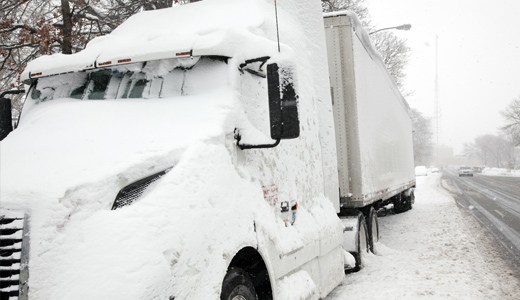




Road warriors who travel New Jersey's snow-littered roads should be a trifle less exposed to danger than ever before thanks to NJSA 39:4-77.1. This new state law makes it a driving offense to carry snow or ice anywhere on our vehicles for the simple reason that it can fly into another vehicle with tragic results.
Everybody knows about this danger, especially the 2,000 readers who wrote this column demanding reform, as well as the scores of people we've catalogued over the years whenever they've felt the sting of the snow and ice that fell twice. This group includes a governor, a congressman, a couple of police chiefs, several drivers from out of state and even a few truckers, yet no state Legislature anywhere was willing to pass a law banning rooftop snow. But last year, after nearly a three-year fight with the trucking industry, New Jersey lawmakers became the first in the nation to do something serious about this winter menace.
So, here's fair warning: Any day now, the first snowfall that settles over your car, SUV, pickup truck or 18-wheeler will bring more than a cold, white covering. At first, expect police only to issue warnings. But after that, expect tickets - $25 for a first offense, and as much as $75 for repeat violations.
Yes, the price for putting the rest of us at risk is small. But you'll be treated to a not-so-brief discussion with a cop who will demand that you roll down your window in subfreezing weather. And if you can't talk your way past him, you'll have a choice of paying the fine or returning to the same jurisdiction to wait your turn to see a judge who, in his or her deepest unuttered thoughts, will likely question the mental health of someone who'd waste time challenging the cheapest fine on the docket. It could be much worse. If flying snow causes damage or injury, the fine is $200 to $1,000 for private cars and $500 to $1,500 for commercial vehicles.
So, why not avoid these risks by sweeping the white junk from your roof and hood? If that's too difficult, shouldn't you reassess whether you really need to be driving on a day when some other risk-taker's snow and ice might slam into your windshield?
Few of us ever consider this, but when 4 inches of snow hardens on a 3-foot-by-2-foot section of roof, it weighs about 150 pounds. Falling just 15 feet at 50 mph, it can do as much damage as a small boulder. Tens of thousands of New Jersey drivers try to dodge these obstacles each winter, although the crashes they cause don't rate a category in formal crash records, and nobody counts near-misses - except for the time that this column did its own unofficial count and 2,000 readers responded, most of them with horror stories supported by pictures.
Over the years, we've built up a frosty gallery, many of them vehicles owned by government agencies, such as school boards, police departments and the U.S. Postal Service, as well as big companies whose drivers should know better.
www.northjersey.com
Here’s a bit of good news as 2010 draws to a close: analysts at Fitch Ratings that a number of positive trends are coming together to favor the freight hauling business next year. And while we’re not talking about a truly rosy outlook here – worthy of popping champagne corks and the like – it’s definitely cheerful considering the rough patch the trucking industry has been slogging through.
Fitch’s experts expect increased stability in the ratings for U.S. transportation companies in 2011, driven by modest volume growth, consistent core pricing improvements, strong liquidity, and steadily declining leverage metrics.
As U.S. freight haulers continue to benefit from what is believed to be a sustainable economic recovery, they further expect improved profitability and cash flow generation improvement, leading to an overall strengthening of the industry’s credit profile. Now, although credit quality is improving, Fitch does not expect many positive rating actions in 2011 due to limited debt reduction, regulatory uncertainty and the expectation for increased discretionary spending. Fitch’s analysts said market conditions in the trucking industry should continue to show improvement into 2011, with utilization and pricing improvements will remain the primary focus of the sector’s largest competitors. Nonetheless, overcapacity continues to plague the industry and is likely to remain a headwind to yield increases in 2011, though Fitch expects companies will remain disciplined in their efforts to constrain capacity and improve the industry’s operating leverage.
So, what’s behind the optimism? One piece of data comes from TransCore’s spot market freight volume, which, since August, has exceeded same-month levels for every year since 2005 – the peak year for truckload freight on the spot market. November was no exception, up 72% from a year ago, according to the firm’s North American Freight Index. On top of that, Fitch said the expected seasonal decline from October to November was just 2.3% – significantly less than the 16% average over the past five years, a further indication of spot market freight strength going into the holidays.
TransCore also reported improving spot market rates, confirming November’s robust volume, with national average line-haul rates for refrigerated and flatbed trucks alike rising by 0.7% on the spot market month-over-month, while van rates remained stable.
Again, does this mean it’s time to break out the brass bands and start throwing confetti about? No way. Many carriers – TL and LTL, larger and small alike – are still too busy just trying to survive. But at least the tide seems to be firmly turning here in favor of trucker, and that’s definitely something to be cheerful about.
www.fleetowner.com
| Privacy Policy | Terms of Use | Advertise with Us | |
|
Mail Address: DorogaRoad. 321-330 Princess Royal Dr., Mississauga, ON, L5B 4P7, Canada Tel: 416.500.5950 • E-mail: [email protected] |
© 2007-2026 DorogaRoad.com. All rights reserved. © 1998-2026 Powered by AdSprouts solutions for publishers |